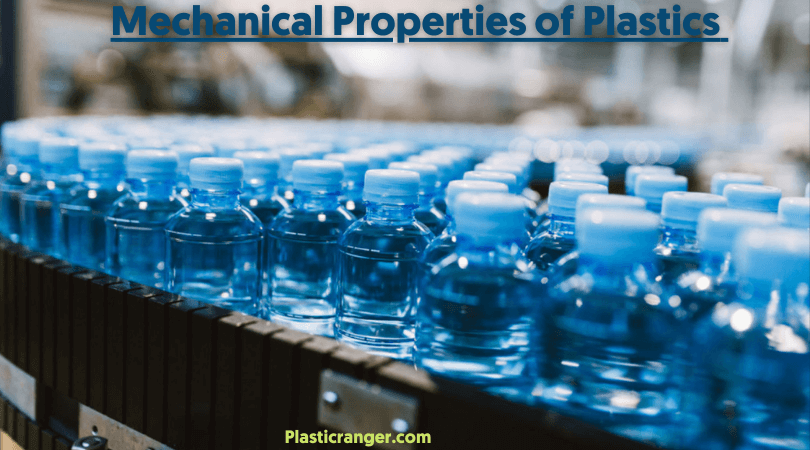Plastic material properties, especially mechanical properties, are significant for any plastic professional wanting to make quality products. Let’s dive into the article, talking about this in detail.
What are the Mechanical Properties of Plastic Materials?

Hello people, Today, we’ll be looking at the mechanical properties of all mainstream plastic materials. Below is the easiest bifurcation of all mechanical properties possessed by plastics.
| Materials | Tensile Strength | Tensile Elongation | Compression Strength | Tensile Modulus of Elasticity | Flexural Strength | Flexural Modulus of Elasticity | Hardness | Izod Impact |
| ASTM TEST | psi D638, 73°F | % D638, 73°F | psi D695, 73°F | psi D638, 73°F | psi D790, 73°F | psi D790, 73°F | Scales – D785, D2240, 73°F |
ft-lbs/in D256, 73°F
|
| ABS | 4100 | 32 | – | 294,000 | 9100 | 304,000 | R102 | 7.7 |
| Acetal | 10000 | 75 | – | 450,000 | 14300 | 420,000 | M89, R121, Shore D 83 | 1.5 |
| Acrylic | 10000 | 4.5 | 17,000 | 400,000 | 17,000 | 480,000 | M95 | 0.4 |
| CAB – cellulose acetate butyrate | 5,221 | 33.9 | – | 400,000 | – | 230,000 | – | 4.4 |
| CE – Canvas Phenolic | 9,000 | – | 34,000 | – | 15,000 | 1,500,000 | M100 | 1.5 |
| Polyamide | 12,400 | 90 | – | 470,000 | 17,000 | 410,000 | M85, R121, Shore D 80 | 1.2 |
| ECTFE – Ethylene Chlorotrifluoroethylene | 8,000 | 300 | – | 250,000 | – | 145,000 | Shore D 73 | No breaking |
| HDPE | 4,000 | 600 | 30,000 | – | – | 200,000 | Shore D 69 | – |
| PBT | 8,690 | 300 | – | 416,000 | 12,000 | 330,000 | M72 | 1.5 |
| PEEK | 14,000 | 60 | – | 400,000 | 24,600 | 590,000 | M105, R126, Shore D 85 | 1.6 |
| PET | 11,500 | 70 | – | 400,000 | 15,000 | M93, R125, Shore D 87 | 0.7 | |
| PETG | 7,700 | 210 | – | 320,000 | 11,200 | 310,000 | R115 | 1.7 |
| Polycarbonate | 9,500 | 135 | 12,500 | 345,000 | 135,000 | 345,000 | M70, R118, Shore D 80 | 12.0 – 16.0 |
| Polypropylene | 5,400 | – | – | – | – | 225,000 | Shore D 75 | 1.2 |
| PTFE | 2,500 | 150 | – | – | – | 72,000 | Shore D 55 | 3.5 |
| PVC | 7,500 | – | – | 411,000 | 12,800 | 481,000 | R115, Shore D 89 | 1 |
| PVDF | 7,800 | 35 | – | 350,000 | 10,750 | 310,000 | M75, R84, Shore D 77 | 3 |
| TPE | 1,740 | 31 | – | – | – | – | – | – |
| UNMW | 3,100 | 350 | – | – | – | 110,000 | Shore D 64 | * |
All the values and technical information mentioned above are for information purposes only. After extensive research, all the values have been figured out, but consulting with your material supplier is advised for accurate figures.
Definition – Mechanical property is the physical attributes a material shows upon force application.
The Purpose of Mechanical Properties in Plastics

Mechanical Properties are a crucial part of a product’s integrity. Factors like tensile strength, elongation, compression strength, flexural strength, hardness, and elasticity can improve a product’s quality and applications.
Let’s examine the purpose and importance of some of the above attributes.
Impact Strength
The impact strength in thermoplastics is measured by either Charpy or Izod impact tests. The string method is simple but effective.
A rectangular rod is placed in a pendulum at high speed, and the energy absorbed while breaking the sample is measured.
The higher the number, the more excellent the impact resistance. In some instances, plastics with high resistance values do not break, resulting in no usability.
The test will be repeated serval times with a north made on the sample to obtain details under a more dreadful condition.
The plastics with high impact strength are:
- ABS
- Polycarbonate
- EVA
- CAB
- ETFE
- ECTFE
Compressive Strength
Compression strength is measured by constantly increasing force on cubical or cylindrical samples placed between two plates, thereby measuring elongation and pressure.
One important thing to note is that the compression property at break is not always accurate because ductile material samples tend to deform without clear breakage.
Unrestrained deformation under load isn’t a reliable indicator of success in real-life industrial applications.
For those reasons, the compressive street is not determined at the break but at a defined deformation point (Usually 1,2, or 10%).
Another smart move would be to check the test conditions before comparing compression values from different sources.
A reliable method to improve or enhance the compression strength of any thermoplastic polymer is to add carbon fiber or glass fiber reinforcements.
However, due to enhancements in creep properties, apparent effects on the load performance are noticeable in the long rather than the short term (That means patience is the key).
The thermoplastics with impressive compressive strength are:
- ABS
- Acrylic
- Acetal
- Polycarbonate
- HDPE
- Polyethylene
Engaging Read – Physical Properties of Plastic Materials | The Complete Guide
Hardness
While several methods measure hardness in a thermoplastic, the most common method is “ball indentation hardness.”
A sphere-shaped metallic ball of standard dimensions is pressed into material with a particular force; the residual mark will define the hardness value for a certain amount of time.
Another method, “Rockwell Hardness testing,” is famous for determining hardness.
Carbon fiber and glass fiber-filled materials show the highest surface hardness.
The materials exhibiting excellent hardness are:
- Polypropylene
- Polycarbonate
- HDPE
Tensile and Flexural Strength
Flexural strength for any thermoplastics is yielded through the flexure test. In that test, a sample rectangular or circular is bent until a fracture occurs. The flexural strength represents the highest stress experienced by the material in its moment of yield.
Talking tensile strength is the maximum stress a plastic material can resist while being stretched before breaking. Tensile strength is more critical in brittle materials than ductile materials.
Materials showing phenomenon tensile strength are:
Flexural Modulus of Elasticity
Flexural modulus of elasticity means the stress equation applied to the material along the axis of the sample tested and deformation determined on the same axis. It is also called young’s modulus and elastic modulus. The flexural modulus of elasticity is determined using Hooke’s law.
In Hooke’s law, force is applied to an object which extends it and puts on a behavior pattern using a stress-strain curve in the elastic deformation region. The dimensions, such as length and thickness, also play a significant role in determining the extension of the force.
Flexural modulus is an important mechanical property for selecting the material, product design, and performance analysis.
- To decrease the material costs, look for batch quality and long-term consistency in manufacturing.
- To assist the design process.
- Handy in selecting materials for various purposes by testing them in different circumstances under different types of forces.
FAQs

Below are the frequently asked questions about the mechanical properties of plastic materials. Let’s learn a bit more about the concept.
What are the general properties of polymers?
Its applications decide the general properties of any polymer. Toughness, reliance, high strength, modulus-to-weight ratios, corrosion resistance, electrical conductivity, and transparency are general properties of plastics.
What are the most important mechanical properties of plastics used in construction?
Tensile and flexural strength is the most important mechanical properties.
Which plastic material has the highest Young’s modulus?
EVOH – Ethylene Vinyl Alcohol – has the highest young’s modulus.
What makes mechanical properties so crucial for any material?
If determined correctly, mechanical properties can help the product’s design process and decrease material costs with more valuable and quality manufacturing.
Which is the strongest plastic?
Polycarbonate is the strongest plastic on the market. It is 200 times stronger than plastics and crack-free.
Suggested Read –
- Thermal Properties of Plastics | The Ultimate Guide
- PVC Melting Point, Properties, Applications, Advantages & Disadvantages
- 6 Best Plastic Molding Techniques | A Complete Analysis
Final Thoughts
In summary, plastics exhibit various mechanical properties, making them versatile materials for multiple applications. Their tensile strength, modulus of elasticity, and impact resistance can be tailored through molecular engineering and processing techniques.
However, they generally lack the high-temperature resistance and strength of metals. Innovations like nanocomposite reinforcements and advanced polymer blends are pushing the boundaries, offering enhanced mechanical properties that rival traditional materials in specific applications.
Kindly comment your reviews and thoughts in the comment box
Have a wonderful day.
Quick Navigation

I’m trying to fix a mechanical oven push button that has snapped. It is behind the temperature screen that controls an in increase in temperature. I have Gorrilla Glue which is not recommended for polypropelene , polyethelene, bitumen. How do I determine what it is made of? Believe it or not I melted a piece of tube I cut from a cheap giveaway ballpoint pen. I suspect it is made from one of these plastics not recommended by Gorrila Glue.